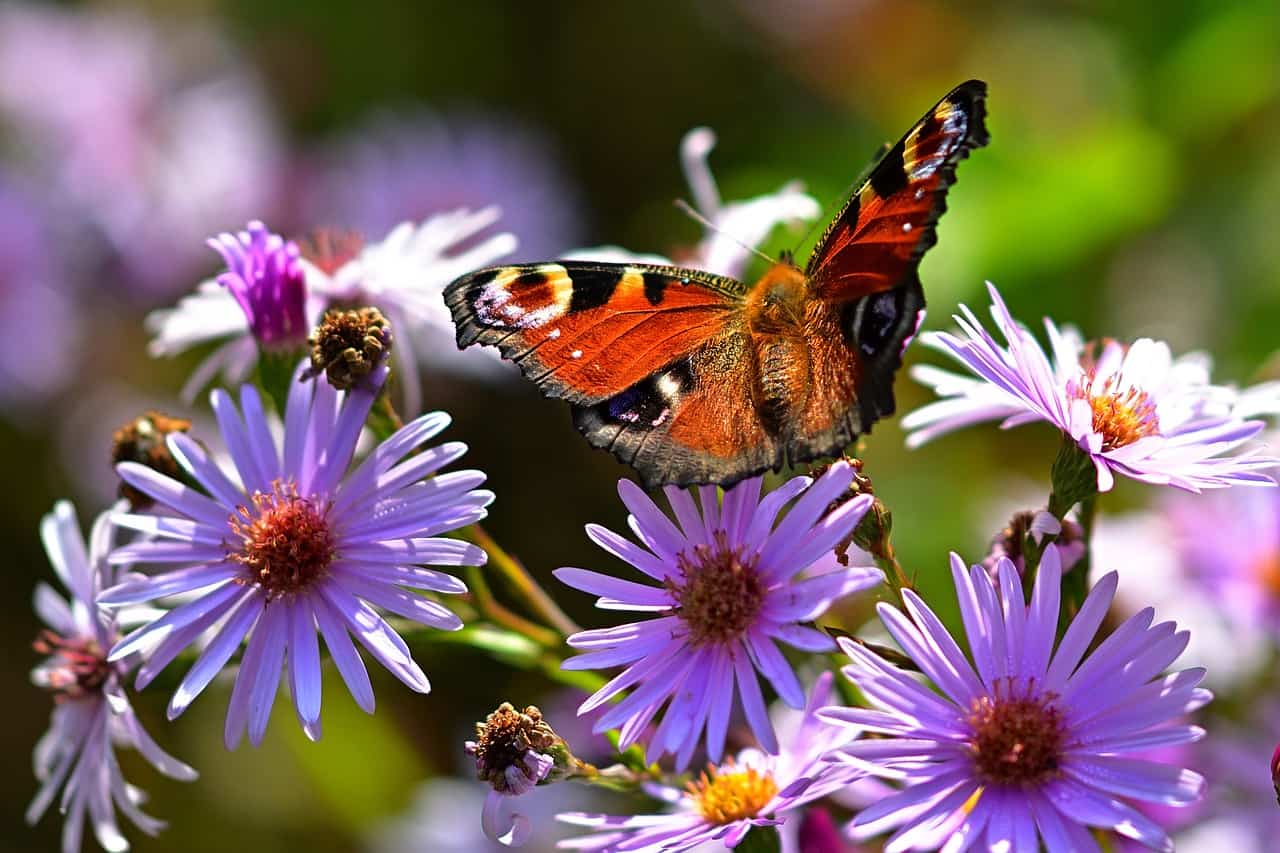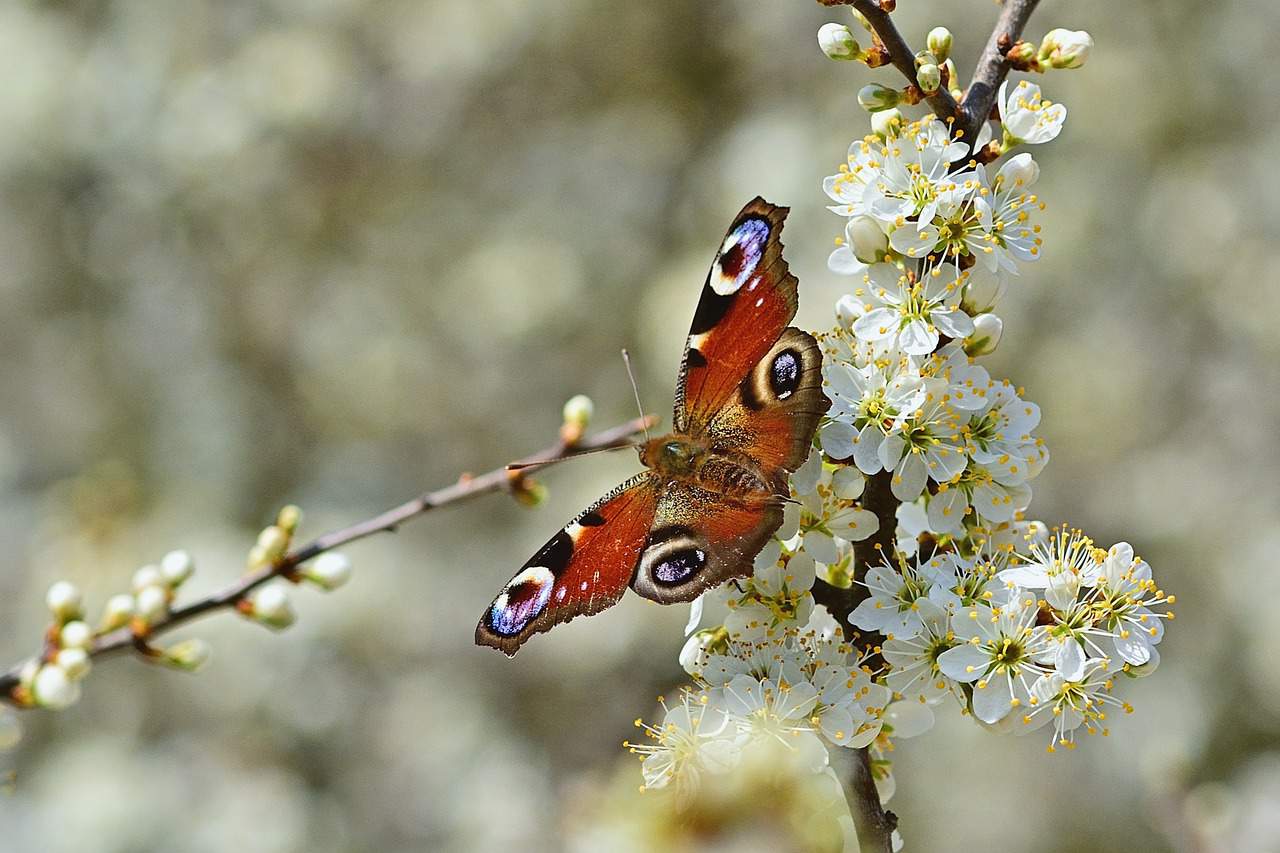
Peacock butterflies are beautiful and vibrantly colored creatures that live in temperate areas of Europe and Asia. You’ll usually see them in woodlands, parks, gardens, and hedgerows, basking in the sun with their wings wide open. If these peacock butterfly facts make you want to go out and see one for yourself, don’t do it in winter.
Peacock butterflies emerge from their cocoons in late summer and hibernate in the winter. For seven to eight months, they hide in hollow trees, dead wood, sheds, and attics until the next spring. This species is one of the first butterflies that are seen during the onset of spring.
Wondering how they got their beautiful name? The name “Peacock” comes from the large “eye spot” on each of the butterfly’s four wings. These eye dots have the appearance of peacock feathers. They may seem lovely and fragile, but don’t their appearance fool you. Peacock butterflies know how to handle predators. As soon as they sense danger, they stop moving and pretend to be a leaf in order to blend in with the surroundings. If disturbed, the peacock butterfly also rubs its wings together to make a hissing sound; this combined with its large eye-spots helps to deter predators.
This stunning creature, with its captivating azure ‘eyes’ and orange-brown wings, is one of the most popular and well-loved creatures in the United Kingdom. If you’re beginning to like them too, come and get to know them better, feed your fascination, check out our top 30 peacock butterfly facts.
- Peacock butterfly has a wingspan of 50 to 55 millimeters or 1.96 to 2.16 inches.
- There are two subspecies of peacock butterflies, the A. io caucasica and A. io geisha.
- Peacock butterflies usually live for around 11 months.
- The eggs of peacock butterflies will hatch within 1 to 2 weeks.
- It usually takes around 12 days before the chrysalis transforms into an adult peacock butterfly.
- The peacock butterfly is a European butterfly that also appears in parts of Asia.
- The base color of peacock butterfly wings is a rusty red.
- Each wingtip has blue, black, and yellow eye-like designs.
- A peacock butterfly lays eggs.
- Peacock butterflies produce hissing sounds.
- The lower side of their wings is dark brown.
- The peacock butterfly’s scientific name is Aglais io.
- They belong to the class of Insecta.
- They hibernate during the winter season.
- The term Io in Aglais io is from the Greek mythology character Io, one of the mortal lovers of Zeus.
- The male and female peacock butterflies have the same patterns on their wings, though their wing sizes differ.
- Peacock butterflies, just like other butterflies, can recognize colors like, red, green, and yellow.
- The color of their wings gives them protection from predators.
- The pattern on the wings of peacock butterflies resembles an owl when seen upside down.
- A peacock butterfly in China represents a healthy life, while in Japan it means marital bliss or happiness in marriage.
White peacock butterflies inhabit are common in Central America and the Caribbean.
Anartia jatrophae or white peacock butterflies commonly live in Central America, the Caribbean, Texas, and Florida. They inhabit areas where water is abundant like ponds or streams, or open areas such as fields and parks. The topside of the white peacock butterfly is white with a round black spot with a light to brown curve on the forewing.
Peacock butterflies use two types of defense against predators.
Peacock butterflies protect themselves against predators in two ways. First, is through crypsis or camouflaging. They blend in with their environment, usually appearing like a dead leaf. Moreover, they can also use their wings to create a hissing sound that can scare off some of their predators. Their common predators are rodents and other avian predators like pied flycatchers and other small, passerine birds.

Male peacock butterflies are extremely territorial.
A male peacock butterfly that holds a range of territory is more likely to attract a female peacock butterfly. Male peacock butterflies defend their space, including nesting sites, watering holes, and food areas. They perch on an object at a specific height to view the passing flying objects, defend their territory, and look for a mate.
Peacock butterflies lay around 400 eggs at a time.
In early spring, peacock butterflies lay as much as 400 eggs at a time. They lay ridged, olive-green eggs on the leaves of nettle (a flowering plant native to Europe), and hops, a climbing plant.
Peacock butterfly caterpillars mainly feed on nettle plants.
After the eggs are hatched, caterpillars emerge. Peacock butterfly caterpillars are black with white dots on their body and shiny blackheads. They can grow up to 42 millimeters or 1.6 inches in length, and mainly feed on nettle plants. Moreover, these caterpillars are also known for their spikes.
The pupa of the peacock butterfly emerge during July.
The pupa of peacock butterflies, just like the other species of butterflies, is attached to the plant stems or leaves for support. They may be either brown, gray, or green in color. It has rough or sharp points all over the body that make it look like a leaf.
Peacock butterflies feed on the nectar of flowering plants.
Adult peacock butterflies eat a variety of food than the ones in caterpillar form. They sip the nectar of different types of flowering plants including clover, dandelions, willows, and buddleia; they also feed on tree sap and rotten fruits.
Peacock butterflies are monogamous.
Peacock butterflies observe monandrous systems, which means that for a period of time they only mate with one partner. This is because of their life cycle wherein female peacock butterflies mate during the pupal stage. Moreover, they also mate once after overwintering or when butterflies enter a dormant phase, usually in pupa or caterpillar form.
Their habitat consists of temperate regions across Europe and Asia.
Generally, peacock butterflies inhabit temperate areas like fields, meadows parks, and gardens. In cold weather, they look for places with constant temperature, and sometimes occupy hollow trees, attics, and sheds. Throughout this time they fold their wings and sleep.

Peacock butterflies play an important role in the environment.
They play an important role in the environment as pollinators. Just like other butterflies, they help the flowers to reproduce through pollination. As they sip the flower’s nectar, the pollens attached to them are transferred from one flower to another.
Was this page helpful?
Our commitment to delivering trustworthy and engaging content is at the heart of what we do. Each fact on our site is contributed by real users like you, bringing a wealth of diverse insights and information. To ensure the highest standards of accuracy and reliability, our dedicated editors meticulously review each submission. This process guarantees that the facts we share are not only fascinating but also credible. Trust in our commitment to quality and authenticity as you explore and learn with us.
